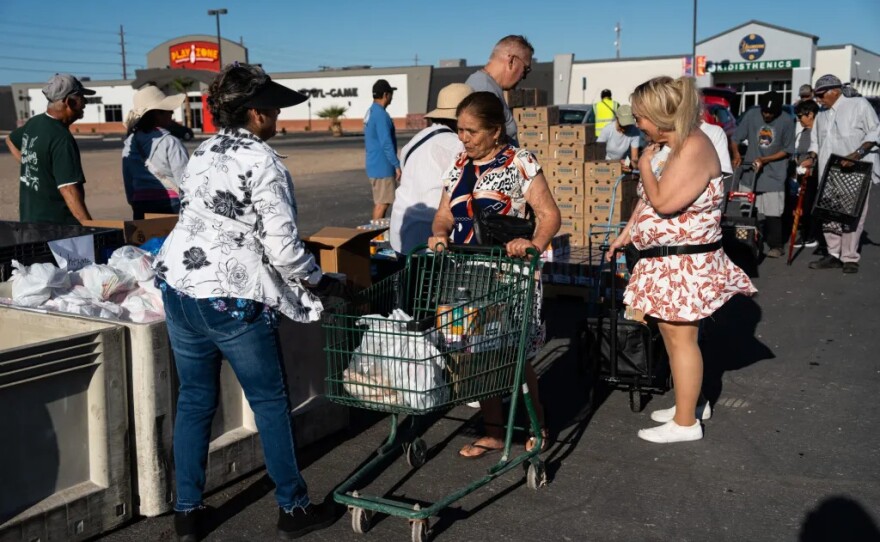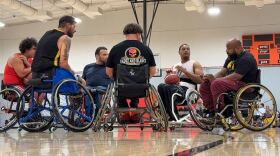Imperial County residents, leaders and health care professionals are bracing as House Republicans push billions of dollars in cuts over the next decade to Medicaid, the health care program that covers more than half of the county’s residents.
Pablo Velez, the CEO of El Centro Regional Medical Center, says the cuts would be “devastating” to Imperial Valley communities. The Medicaid program sends money to states to provide health insurance for vulnerable people, including those who are low-income, pregnant or elderly, people with disabilities and children. Hospitals in rural areas depend heavily on Medicaid to fund their operations.
“Every hospital in California is looking at (the cuts) very closely,” Velez said. “These programs help with bringing additional dollars so that we at least shorten the gap between the cost of care that we provide to the community and what we’re getting reimbursed by the state and the federal government.”
On Wednesday, a House panel approved $880 billion in cuts over nine years mostly coming from Medicaid. The proposal, aimed at offsetting some of the nearly $5 trillion in tax cuts pushed by the Trump administration, now goes to the House Budget Committee, according to reports. Protesters, including some in wheelchairs, interrupted the panel’s proceedings. Several were arrested.
Some low-income community members in Imperial County are worried about what cuts could mean for them. Not only could cuts reduce their health benefits, but they also could increase pressure on the patchwork support systems many depend on to make ends meet, they told inewsource.
“We’re not even living our life how we should be because we’re so worried about our basic needs,” said Karen Alvarez, an Imperial Valley College student and single mother of three.

Though the Republican plan avoided deeper cuts being considered to the federal health care program, it includes measures such as work requirements and other new mandates and would cause and estimated 13.7 million people to lose their insurance by 2034.
For residents of Imperial County the stakes are high. More than half the population is enrolled in Medi-Cal, the state’s Medicaid program. The county has among the state’s highest in unemployment rates and the lowest number of doctors per capita. Experts say any cuts will hit the community hard.
The federal government contributes about $108 billion to California’s $175 billion Medi-Cal budget. Medi-Cal covers 14.9 million people, about one in three Californians.
As health care costs increase and California confronts a state budget deficit, cuts to federal support have leaders worried about how or if they could pick up the bill.
State Sen. Steve Padilla, D-Chula Vista, who represents Imperial Valley, said that on the state level they are “bracing” for the impacts of such cuts, calling them “an irresponsible action.”
“It’s irresponsible and distressing for an administration that seems to have captured a lot of support in the last election from some working people to turn around and to harm the most vulnerable in our working people in our state,” he said.
Newly elected State Assemblymember Jeff Gonzalez, R-Indio, who flipped the seat in Imperial Valley, said he supports cuts to the program if they focus on aspects that don’t harm quality of care and don’t hurt the people who need it most. He said his son, who has special needs, is “completely disabled” and has Medicaid.
Gonzalez said lawmakers must take a “methodical look” at where they can find savings in the program.
“Let’s get back to the coupon mentality in running government,” he said.
U.S. Rep. Raul Ruiz, D-Coachella, who was an emergency room doctor, says while the cuts are being sold as a way to make the government more efficient, they target a lifeline supporting an already precarious health care system.
“The only way they’re going to be able to cut expenditures on Medicaid is by dropping health coverage for people who need it,” Ruiz said.
Even before talks of Medicaid cuts, hospitals in Imperial County have been struggling.

Like many rural hospitals in the U.S. they are unable to provide more lucrative specialized services and are having to cut programs to keep doors open.
After El Centro Regional Medical Center shut down its maternity ward in 2023, Pioneers Memorial Hospital took on more patients. The closure overwhelmed health workers at Pioneers and sent many mothers in search of healthcare outside the county, including San Diego a couple hours away.
Now hospital leaders in the county are alarmed that the proposed cuts could exacerbate unresolved long-standing issues. They are calling on legislators to avoid cuts.
“We’ve been talking to all our elected officials to try to mitigate the cuts,” El Centro CEO Velez said.
The proposed budget would curb the state’s ability to tax providers, a key revenue stream for helping states fund their Medicaid programs, and would also affect Medi-Cal recipients directly by requiring them to continually prove their employment status.
“Imagine the single mom working two jobs to make ends meet for her family, and on top of, you know, cooking, cleaning, working, now they have to worry about submitting proof that they’re working every four to six months,” Congressman Ruiz said.
Medi-Cal has helped Alvarez and her colleague Stephanie Maldonado, both Imperial Valley College students and single mothers. They say Medi-Cal has provided health care for them and their children, but even with the resources, booking appointments often means months of waiting. Meanwhile Alvarez studies, works and relies on a number of programs backed by both state and federal funds to help her make ends meet.
Imperial Mayor Pro-Tem Ida Obeso-Martinez says health care in Imperial Valley includes access to a network of services.

“What does that do to our IV food bank down the way? What does that do to people who use those ancillary services,” said Obeso-Martinez, a cardiac nurse practitioner. “Maybe you have a kid or an adult who’s disabled, … what happens then?”
The Dillon family has the same questions.
A single father, Corban Dillon works part-time for a geothermal company and is going back to school. He lives with his mother who has severe asthma.
He relies on Medi-Cal and various food assistance programs. His mother and her late husband ran a courier business for 45 years, working 18 hours a day. She too relies on public assistance, and she says it’s barely enough to survive.

“We were hard working people. It’s not like we’re lazy,” Julie Dillon said.
After all their expenses and all their hard work, she says she can’t afford her medicine. She has to buy it in Mexico.
Corbon Dillon said they’re U.S. taxpayers “having to go to a different country to receive services such as health care.”
“At the end of the day it’s not right,” he said.







